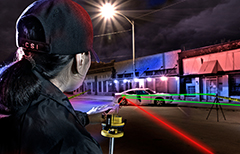FSA112 – 40.00 Hours
Schedule
| Details Buttons | Dates | Location | Class | Price | Register Buttons |
|---|---|---|---|---|---|
| 05/20/24 – 05/24/24 | Humble, TX | LS FSA112 41 | $610.00 | Register |
This schedule is subject to change without notice. If you have not received confirmation of the class prior to the class start, please contact the division at (800) 423-8433 or [email protected] to get the latest schedule.
Course Description
 Once an investigator has mastered basic forensic photography, there are advanced skills and techniques that can allow for greater effectiveness in documenting crime scenes and physical evidence. Participants will learn photographic techniques such as low light/nighttime, ultraviolet, infrared, and laser photography. Course instruction is through lecture, case review, and application exercises.
Once an investigator has mastered basic forensic photography, there are advanced skills and techniques that can allow for greater effectiveness in documenting crime scenes and physical evidence. Participants will learn photographic techniques such as low light/nighttime, ultraviolet, infrared, and laser photography. Course instruction is through lecture, case review, and application exercises.
This course meets Texas Commission on Law Enforcement (TCOLE) requirements Texas Forensic Science Academy Forensic Photography II Course #40054.
Participant Testimonials:
- “15 years CSI and still learned many new techniques.“
- “They had great hands-on activities and materials which aided in the learning process for this course.“
Prerequisites
Participants enrolling in this course must complete the following courses prior to attendance:
Enrollment Requirements
Participants enrolling in this course must meet one of the following employment statuses. Please ensure the affiliation on your student account reflects one of the following:
- Licensed or certified peace officer with a current commission employed by or attached to a law enforcement/investigative agency
- Civilian employed by a law enforcement/investigative agency conducting investigative tasks or duties
- Nurse employed by a medical facility tasked with conducting forensic examinations
- Investigators from government agencies (such as Child Protective Services) and private entities (such as insurance companies) responsible for photographic documentation
Participants will be contacted via email to confirm approval and admittance into the course.
Course Completion Requirements
Participant Must Provide
- A photo identification on the first day of class. See the Participant Handbook for approved forms of identification and additional guidelines.
- Laptop or tablet
- Camera (pick one of the following)
- Digital SLR
- Mirrorless
- Electronic flash
- Tripod
- Flashlight
Attendance Requirements
Class attendance is an essential part of the education process, and participants in TEEX courses are expected to attend all class sessions and field exercises. The course requires participants to attend a minimum of 80% of the class hours as a component of successful course completion. During the course, your instructor will review any additional attendance requirement, for example a field exercise that cannot be missed.
Participants in a TCOLE credit course must complete the class in its entirety to receive TCOLE credit.
Recommended
Participant May Bring
- Camera cable release
- Macro lens, diopters, or extension tubes
- Color contrast filters
- Photographic (forensic) barrier filters
- Blue #47 glass filter
- RM72 infrared glass filter
- Camera instruction manual
- Electronic flash instruction manual
- Extra batteries for camera and flash
- Laptop computer and photo card reader (for photo review)
Upon successful completion, you will be able to:
- Equipment and basic exposure review
- Macro photography
- Nighttime photography
- Reciprocity failure
- Flash photography
- Painting with light
- Shooting reconstructions
- Bloodstain photography
- Ultraviolet and infrared photography
- Photographic perspective
Suggested Audience
- Law enforcement and non-commissioned personnel assigned to investigative tasks and duties such as crime scene investigators, fire investigators, detectives, medicolegal death investigators, patrol officers, corrections officers and forensic nurses
Continuing Education And Professional Credits
Note: Live Online Instructor-Led (webinar) courses are not eligible for TCOLE credit.
- 40.00 hours – Texas Commission on Law Enforcement (TCOLE)
- 3.00 hours – American Council on Education (ACE)
- International Association of Identification (IAI)
Other Information
Class Schedule
- This course is presented in evening/nighttime hours. Review specific course delivery locations for class start/end time
International Association of Identification
You are responsible for contacting International Association of Identification (IAI) after successfully completing the TEEX course to submit the necessary documentation for your desired certification. IAI credit hours are currently available for the following credits:
- Crime Scene Certification (issued 3/14/2024), Initial (40 hrs) or Recertification (40 hrs), and
- Forensic Photography Certification (issued 3/18/2024), Initial (40 hrs) or Recertification (40 hrs).
Contact Information
Institute for Law Enforcement and Protective Services Excellence
Phone: (979) 845-6677 | Toll-Free: (800) 423-8433
Email: [email protected]
Payment Info
- Credit Card – Complete online registration or call (979) 845-6677
- Purchase Order – Complete registration form and send to [email protected] or fax to (877) 289-9715
- Check – Complete registration form and mail to: TEEX – ILEPSE, P.O. Box 40006, College Station, TX 77842
